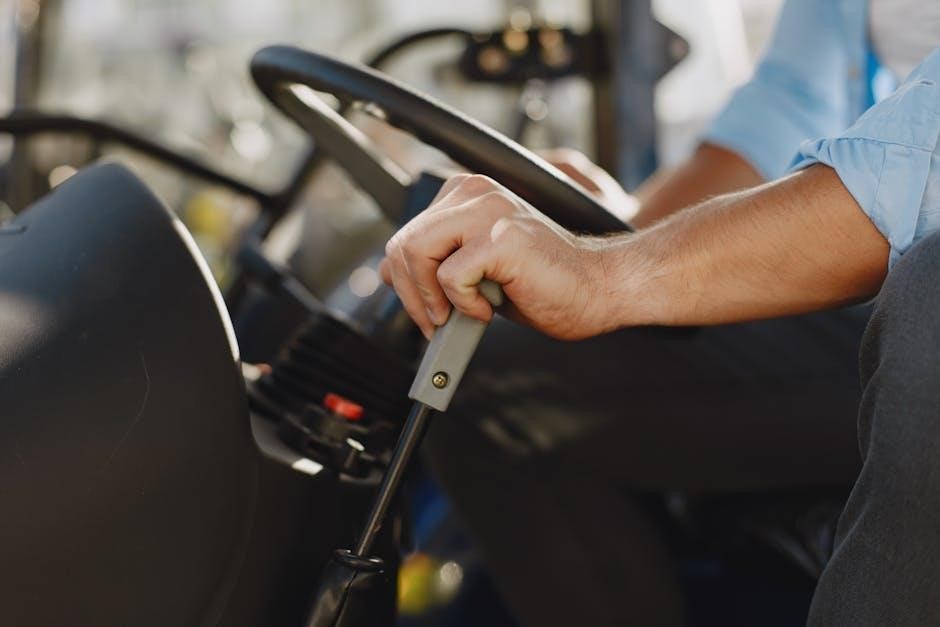The Minnesota Driver Manual is a comprehensive guide detailing state driving laws, safe practices, and licensing procedures. It serves as an essential resource for all drivers.
1.1 Overview of the Minnesota Driver Manual
The Minnesota Driver Manual is a detailed guide covering essential topics for drivers, including road rules, safe driving practices, and licensing steps. Updated annually, it reflects current laws and regulations. The manual is available in multiple formats, such as PDF and audio versions, to accommodate different learning preferences. It serves as the primary study resource for the knowledge test, ensuring drivers understand their responsibilities and legal requirements. Regular updates ensure the information remains relevant and accurate for all Minnesota drivers.
1.2 Importance of Reading the Manual
Reading the Minnesota Driver Manual is crucial for understanding state-specific driving laws, safety tips, and licensing requirements. It prepares individuals for the knowledge test, ensuring they grasp essential road rules and regulations. The manual also highlights the legal and safety responsibilities of drivers, promoting informed and safe driving practices. By studying it thoroughly, new and experienced drivers can reduce risks and contribute to a safer road environment for everyone in Minnesota.
1.3 Updates and Changes in the 2025 Edition
The 2025 Minnesota Driver Manual includes updated guidance on traffic stops, particularly for drivers carrying firearms, and reflects changes in state laws and driving regulations. It also introduces new sections on distracted driving awareness and enhanced road safety measures. The manual now offers audio versions and multilingual support, improving accessibility for all drivers. These updates ensure the manual aligns with current laws and promotes safer, more informed driving practices across Minnesota.

Obtaining a Minnesota Driver’s License
Obtaining a Minnesota driver’s license involves meeting eligibility requirements, providing necessary documentation, passing vision and knowledge tests, and completing a road test. Fees apply for licensing.
2.1 Eligibility Requirements
To apply for a Minnesota driver’s license, applicants must meet specific eligibility criteria. Individuals under 18 must complete a driver’s education course and provide parental consent. A vision test is required for all applicants. Those under 21 face restrictions on driving hours and passenger limits. Proof of legal residency and identity is mandatory. Applicants must pass a knowledge test and road test to demonstrate driving proficiency. Additional requirements apply for commercial or motorcycle licenses, ensuring safety and compliance with state regulations.
2.2 Documentation Needed
Applicants must provide specific documents to obtain a Minnesota driver’s license. Proof of identity, legal status, and residency are required. Acceptable documents include a valid passport, birth certificate, or Social Security card. Additional proof of residency, such as a utility bill or bank statement, is necessary. Minors under 18 must provide parental consent. The Minnesota DVS website offers a detailed list of acceptable documents. Ensuring all required paperwork is complete helps streamline the licensing process and avoids delays.
2.3 Knowledge Test Preparation
The Minnesota knowledge test assesses understanding of road rules, traffic signs, and safe driving practices. Study the MN Driver Manual thoroughly, focusing on sections like traffic laws and road signs. Practice tests are available online to help gauge readiness. The manual is the primary study resource, covering essential topics. Additional aids, such as audio versions and interactive tools, can enhance preparation. Familiarize yourself with test formats and content to ensure confidence and success on exam day.
2.4 Vision Screening Process
All applicants must pass a vision screening to ensure they meet Minnesota’s visual standards for driving. The test evaluates visual acuity and peripheral vision. Those with corrective lenses must wear them during the test. If the screening is failed, a medical evaluation may be required. Proper vision is crucial for safe driving, ensuring drivers can react to road conditions and signs effectively.
2.5 Road Test Requirements
The road test evaluates your ability to safely operate a vehicle, demonstrating skills like turning, merging, and parking. You must provide a properly insured, registered, and safety-inspected vehicle. A licensed driver must accompany you to the test. Applicants under 18 need to complete a driver’s education course, including behind-the-wheel training. The test assesses your ability to follow traffic laws and drive defensively. If you fail, you may need to wait before retaking the test, ensuring you meet Minnesota’s driving standards.
2.6 Fees Associated with Licensing
Licensing fees in Minnesota are standardized by the Driver and Vehicle Services Division (DVS). The cost varies depending on the type of license, such as Class D, CDL, or Motorcycle. Fees cover application, knowledge tests, road tests, and license issuance. Payment methods vary by location, and additional fees may apply for third-party testing services. The Minnesota DVS manual provides detailed fee structures, ensuring transparency. Stay informed by checking the DVS website for the most current fee information before applying.

Vehicle Requirements and Maintenance
Vehicle requirements ensure safety and efficiency. Regular inspections maintain equipment functionality. Fuel-efficient driving techniques reduce emissions. Proper maintenance enhances roadworthiness and longevity of your vehicle.
3.1 Vehicle Equipment Requirements
Vehicle equipment requirements ensure safety and compliance with Minnesota state laws. All vehicles must have functional brakes, tires, lights, and signals. Windshields and wipers are mandatory for clear visibility. Safety belts and proper mirrors are also required. Regular inspections verify these components are in good condition. Non-compliance can result in failed inspections or penalties. Proper maintenance of equipment is essential for roadworthiness and preventing accidents. The manual outlines specific guidelines for vehicle upkeep and legal standards to follow.
3.2 Fuel-Efficient Driving Techniques
Fuel-efficient driving techniques help minimize fuel consumption while reducing emissions. Maintaining a steady speed, avoiding sudden acceleration, and braking smoothly can improve mileage. Proper tire pressure and regular vehicle maintenance also enhance fuel efficiency. Reducing idling time and eliminating unnecessary weight in the vehicle are additional strategies. Driving at moderate speeds and using cruise control on highways can further optimize fuel use. These practices not only save money but also contribute to environmental sustainability and extend the life of your vehicle.
3.3 Regular Vehicle Inspections
Regular vehicle inspections are crucial for ensuring safety and legal compliance. Drivers should check tires, brakes, lights, and fluids regularly. Inspecting belts, hoses, and wipers is also essential. A pre-trip checklist can help identify potential issues before they become hazardous. Annual inspections by certified professionals are recommended to comply with state regulations. Proper maintenance not only prevents accidents but also extends the vehicle’s lifespan and ensures reliable performance on the road.

Road Rules and Safe Driving Practices
Understand Minnesota’s traffic laws, including speed limits, right-of-way rules, and safe practices like maintaining a safe distance and using signals. Share the road responsibly with others.
4.1 Traffic Laws and Regulations
Minnesota’s traffic laws ensure road safety and order. Key regulations include speed limits, right-of-way rules, and mandatory seat belt use. Drivers must adhere to blood alcohol content limits and yield to emergency vehicles. Understanding these laws is crucial for legal compliance and accident prevention. The manual outlines specific penalties for violations, emphasizing responsible driving practices. Staying informed about updates ensures compliance with evolving traffic regulations. These laws are designed to protect all road users and promote a safe driving environment statewide.
4.2 Sharing the Road with Other Drivers
Sharing the road safely requires respect and awareness of all drivers, pedestrians, and cyclists. Always maintain a safe distance, yield when necessary, and avoid aggressive behavior. Be mindful of vehicles entering traffic and use signals to communicate intentions. Courtesy and patience reduce conflicts. The manual emphasizes the importance of being alert to other road users, ensuring smooth traffic flow and minimizing risks. Safe coexistence on the road benefits everyone and prevents accidents, fostering a harmonious driving environment for all.
4.3 Safe Driving Practices
Safe driving practices are crucial for minimizing risks on the road. Maintain a safe speed, adjust to weather conditions, and keep a proper following distance. Always wear a seatbelt and ensure all passengers do the same. Avoid distractions like using a phone while driving. Stay alert and focused, anticipating the actions of other drivers. Never drive under the influence of alcohol or drugs. Defensive driving techniques, such as yielding and signaling, enhance safety. By adhering to these practices, drivers protect themselves and others, reducing the likelihood of accidents and ensuring a safer road environment.

Road Signs and Signals
Road signs and signals guide drivers, ensuring safe navigation. They provide warnings, guidance, and regulatory information, helping drivers make informed decisions and maintain traffic flow efficiently.
5.1 Types of Traffic Control Devices
Traffic control devices include signs, signals, and pavement markings that regulate and guide drivers. Regulatory signs, like stop or yield signs, enforce traffic laws. Warning signs indicate hazards ahead, such as curves or pedestrian crossings. Guide signs provide directional or informational content. Traffic signals control the flow of vehicles and pedestrians, while pavement markings, like lane dividers, enhance road safety. Understanding these devices is crucial for safe and legal driving in Minnesota.
5.2 Understanding Road Signs
Understanding road signs is crucial for safe and legal driving in Minnesota. Road signs are categorized into regulatory, warning, guide, construction, and emergency types. Regulatory signs, like stop or speed limit signs, enforce traffic laws. Warning signs alert drivers to hazards, such as curves or pedestrian crossings. Guide signs provide directional or informational content. Recognizing shapes, colors, and symbols helps drivers react quickly. Familiarizing yourself with these signs ensures compliance and reduces accidents, making it essential for all motorists.
5.3 Traffic Signal Rules
Traffic signals are critical for maintaining order and safety on Minnesota roads. Drivers must obey all signals, including red, yellow, and green lights. A green light allows drivers to proceed, while a red light requires a full stop. Yellow lights indicate the light will soon turn red, and drivers should prepare to stop. Special signals, like arrows or pedestrian signals, provide additional guidance. If a signal is malfunctioning, treat it as a four-way stop. Understanding and adhering to these rules ensures smooth traffic flow and reduces accidents.

Driver Safety and Responsibility
Driving safely and responsibly is crucial to protect yourself, passengers, and others on the road. Always obey traffic laws, stay alert, and maintain a safe following distance.
6.1 Impaired Driving Laws
Minnesota strictly enforces impaired driving laws to ensure road safety. Drivers with a blood alcohol concentration (BAC) of 0.08% or higher face legal consequences. Penalties include fines, license suspension, and potential jail time. Repeat offenses escalate penalties, emphasizing the importance of responsible driving. The state also adheres to a zero-tolerance policy for underage drivers, with any detectable alcohol level resulting in immediate consequences. These laws aim to protect all road users and promote a culture of safe, sober driving.
6.2 Distracted Driving Awareness
Minnesota emphasizes distracted driving awareness to reduce accidents. The manual highlights risks of using electronic devices, eating, or grooming while driving. Texting is banned for all drivers, and novice drivers face stricter restrictions. Hands-free mode is allowed, but drivers must avoid any activity that diverts attention from the road. The state encourages mindfulness and responsible habits to minimize distractions, ensuring safer roads for everyone. Staying focused is crucial to preventing collisions and protecting all roadway users.
6.3 What to Do During a Traffic Stop
During a traffic stop, remain calm and follow proper procedures. Pull over safely, turn off the engine, and keep hands visible. Be respectful and cooperative with the officer. Provide required documents promptly. If carrying a firearm, inform the officer immediately. Avoid sudden movements and follow instructions carefully. The MN Driver Manual outlines these steps to ensure a safe and efficient interaction. Understanding your responsibilities helps maintain a positive and lawful encounter with law enforcement.
6.4 Carrying Firearms During a Traffic Stop
The MN Driver Manual now includes guidance for legally carrying firearms during traffic stops. If stopped, immediately inform the officer of any firearms in the vehicle. Clearly state your intent to comply and follow instructions. The manual emphasizes the importance of transparency and cooperation to ensure safety and legal compliance, reducing the risk of misunderstandings during such interactions.

Special Licenses and Permits
This section covers specialized licensing, including Commercial Driver’s Licenses (CDL), motorcycle licenses, and instruction permits, each with unique requirements and regulations outlined in detail.
7.1 Commercial Driver’s License (CDL)
The Commercial Driver’s License (CDL) is required for operating heavy vehicles, buses, and hazardous material transport. Eligibility includes being at least 21 years old and passing rigorous knowledge and skills tests. Applicants must meet medical standards and choose endorsements based on their vehicle type. The 2025 MN Driver Manual details CDL requirements, including restricted licenses and disqualifications. It outlines the process for obtaining and renewing a CDL, ensuring safe and legal commercial driving practices in Minnesota.
7.2 Motorcycle License Requirements
To obtain a motorcycle license in Minnesota, applicants must meet specific requirements. A motorcycle endorsement can be added to a valid driver’s license by passing a written knowledge test and a skills test. Applicants must be at least 16 years old for a motorcycle instruction permit. The manual outlines the process, including vision tests, fees, and required documentation. Completion of a motorcycle safety course may waive the skills test. The endorsement allows operation of two- or three-wheel motorcycles, with restrictions for those under 18.
7.3 Instruction Permits
An instruction permit allows individuals to practice driving under supervision. To qualify, applicants must pass a vision screening and knowledge test. The permit is valid for two years and restricts driving to times when a licensed driver is present. Drivers under 18 must provide parental consent and complete a driver’s education course; The permit is a step toward obtaining a full driver’s license, ensuring new drivers gain experience safely and legally.

Underage Driver Regulations
Underage drivers must obtain an instruction permit before applying for a license, requiring parental consent and completion of a driver’s education course. Supervised driving is mandatory.
8.1 Requirements for Minors
Minors in Minnesota must meet specific requirements to obtain a driver’s license. They must first get an instruction permit, passing vision and knowledge tests. A parent or guardian’s consent is required, along with completion of a state-approved driver’s education course. Minors under 18 must complete 50 hours of supervised driving, including 15 hours at night. Restricted driving hours apply, and all applicants must provide proper documentation and pay the required fees. These steps ensure young drivers are prepared for safe, responsible driving.
8.2 Parental Consent and Education
Parental consent is mandatory for minors applying for an instruction permit or driver’s license in Minnesota. Parents or guardians must sign the application, verifying the minor’s identity and residency. Additionally, minors under 18 must complete a state-approved driver education course, which includes both classroom and behind-the-wheel training. This ensures young drivers receive proper guidance and understanding of traffic laws. Parents are encouraged to participate in their child’s learning process, fostering a safe and responsible driving environment. This collaborative effort promotes effective education and skill development for new drivers.
8.3 Restricted Driving Hours
Minnesota imposes restricted driving hours for minors to enhance road safety. Drivers under 18 with a provisional license are prohibited from driving between midnight and 5:00 AM unless accompanied by a licensed parent or guardian. Exceptions exist for emergencies or when traveling to or from work or school-related activities. These restrictions aim to reduce late-night crashes involving inexperienced drivers, ensuring safer roads for all. Compliance is strictly enforced to protect young drivers and promote responsible habits behind the wheel.

Traffic Violations and Penalties
Traffic violations in Minnesota result in fines, license suspension, or points added to your record. Reckless driving and repeat offenses carry severe penalties to ensure road safety.
9.1 Common Traffic Violations
Common traffic violations in Minnesota include speeding, reckless driving, failure to stop at traffic signals, and driving under the influence (DUI). These offenses often result in fines, license suspension, or points added to a driver’s record. The Minnesota Driver Manual emphasizes the importance of adhering to traffic laws to prevent accidents and ensure public safety. Understanding these violations helps drivers avoid penalties and maintain a clean driving record.
9.2 Consequences of Reckless Driving
Reckless driving in Minnesota can lead to severe penalties, including hefty fines, license suspension, and increased insurance rates. Repeat offenses may result in mandatory community service or even jail time. Points accrued on a driver’s record can lead to license revocation. Additionally, reckless driving increases the risk of accidents, endangering lives. The Minnesota Driver Manual highlights these consequences to emphasize safe and responsible driving practices, ensuring public safety and accountability on the road.
9.3 How Points Affect Your License
In Minnesota, each traffic violation assigns points to your driver’s record. Accumulating 12 points within two years results in license suspension. Points remain on your record for three years, impacting insurance rates and driving privileges. Reckless driving, speeding, and other offenses add points, increasing penalties. Maintaining a clean record avoids higher premiums and license restrictions. The Minnesota Driver Manual emphasizes understanding point consequences to promote responsible driving and avoid legal repercussions. Safe driving habits help keep your record clean and your license active.

Studying the MN Driver Manual
Thoroughly studying the MN Driver Manual is crucial for understanding state driving laws and safe practices. Use the manual’s clear structure to master key concepts effectively.
10.1 Tips for Effective Study
To effectively study the MN Driver Manual, create a structured study plan and set realistic goals. Focus on understanding key concepts rather than just memorizing. Use highlighting to mark important sections and take notes on complex topics. Engage in active learning by summarizing chapters in your own words. Utilize the audio version for on-the-go review and pair it with the PDF for better retention. Test your knowledge regularly with practice tests to identify weak areas. Review mistakes to avoid repeating them. Stay consistent and give yourself time to absorb the information thoroughly.
10.2 Using Practice Tests
Practice tests are a crucial tool for preparing for the MN knowledge exam. They simulate real test conditions, helping you assess your readiness and identify areas needing improvement. Regularly taking practice tests ensures familiarity with the format and content of the actual exam. Focus on understanding mistakes and reviewing incorrect answers to avoid repeating them. Retake tests to reinforce learning and build confidence. Consistent use of practice tests significantly improves your likelihood of passing the exam on the first try.
10.3 Audio and Visual Aids
Audio and visual aids enhance your study experience by providing alternative ways to engage with the MN Driver Manual. An audiobook version of the manual, available as downloadable MP3 files, allows you to listen while following the text. Visual aids like diagrams, charts, and videos clarify complex topics such as road signs and safe driving techniques. These tools cater to different learning styles, making it easier to retain information and prepare for the knowledge test. They are especially helpful for auditory and visual learners.
Additional Resources
Online study guides, driver education courses, and community support are available to supplement your learning. Access downloadable PDF manuals and interactive tools for comprehensive preparation.
11.1 Online Study Guides
Online study guides are readily available to help you prepare for the Minnesota driver’s exam. These guides include interactive practice tests, downloadable PDF manuals, and detailed explanations of driving laws. Additionally, AI-powered tools offer personalized support, providing hints and clarifications for complex topics. These resources complement the official manual, ensuring a thorough understanding of road rules and safe driving practices. Utilize these tools to enhance your study routine and improve your chances of passing the knowledge test with confidence.
11.2 Driver Education Courses
Driver education courses are designed to provide structured learning for new drivers, covering both classroom instruction and behind-the-wheel training. These courses are especially beneficial for minors, as they often require completion before obtaining a driver’s license. They focus on building confidence, understanding traffic laws, and mastering safe driving techniques. Many courses are available online or in person, offering flexibility and comprehensive preparation. These programs align with the Minnesota Driver Manual, ensuring students are well-prepared for the knowledge and road tests.
11.3 Community Support
Community support plays a vital role in helping drivers understand and comply with Minnesota traffic laws. Local organizations and safety initiatives offer resources, workshops, and guidance to promote safe driving practices. Many communities provide access to driver education materials, including the Minnesota Driver Manual, in multiple languages and formats. These efforts ensure that all drivers, regardless of background, can access the information they need to stay safe on the road. Such initiatives foster a culture of responsible driving and mutual support among motorists.
